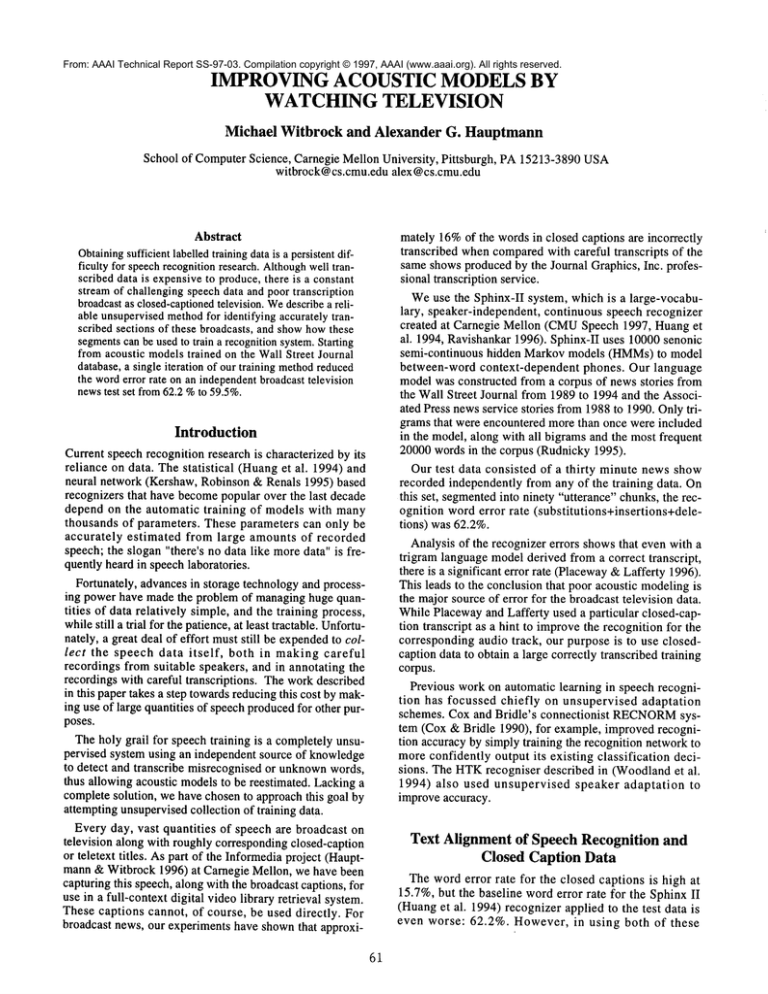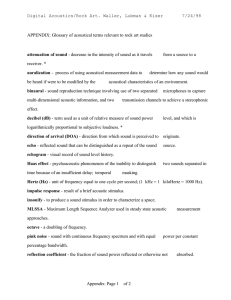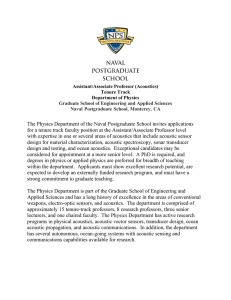IMPROVING ACOUSTIC MODELS BY WATCHING TELEVISION
advertisement

From: AAAI Technical Report SS-97-03. Compilation copyright © 1997, AAAI (www.aaai.org). All rights reserved. IMPROVING ACOUSTIC MODELSBY WATCHINGTELEVISION Michael Witbrock and Alexander G. Hauptmann School of ComputerScience, Carnegie Mellon University, Pittsburgh, PA15213-3890USA witbrock@cs.cmu.edu alex@cs.cmu.edu Abstract Obtainingsufficientlabelledtrainingdata is a persistentdifficulty for speechrecognitionresearch. Althoughwell transcribed data is expensiveto produce,there is a constant stream of challenging speechdata and poor transcription broadcastas closed-captioned television. Wedescribea reliable unsupervisedmethodfor identifying accurately transcribed sections of these broadcasts, and showhowthese segmentscan be usedto train a recognitionsystem.Starting from acoustic modelstrained on the Wall Street Journal database,a single iteration of our training methodreduced the worderror rate on an independentbroadcasttelevision newstest set from62.2 %to 59.5%. Introduction Current speech recognition research is characterized by its reliance on data. The statistical (Huanget al. 1994) and neural network (Kershaw, Robinson & Renals 1995) based recognizers that have becomepopular over the last decade depend on the automatic training of models with many thousands of parameters. These parameters can only be accurately estimated from large amounts of recorded speech; the slogan "there’s no data like more data" is frequently heard in speech laboratories. Fortunately, advances in storage technology and processing power have made the problem of managing huge quantities of data relatively simple, and the training process, whilestill a trial for the patience, at least tractable. Unfortunately, a great deal of effort must still be expendedto collect the speech data itself, both in making careful recordings from suitable speakers, and in annotating the recordings with careful transcriptions. The work described in this paper takes a step towards reducingthis cost by making use of large quantities of speechproducedfor other purposes. The holy grail for speech training is a completely unsupervised system using an independent source of knowledge to detect and transcribe misrecognised or unknownwords, thus allowing acoustic modelsto be reestimated. Lackinga complete solution, we have chosen to approach this goal by attempting unsupervisedcollection of training data. Every day, vast quantities of speech are broadcast on television along with roughly corresponding closed-caption or teletext titles. As part of the Informediaproject (Hauptmann &Witbrock 1996) at Carnegie Mellon, we have been capturing this speech, along with the broadcast captions, for use in a full-context digital video library retrieval system. These captions cannot, of course, be used directly. For broadcast news, our experiments have shownthat approxi- 61 mately 16%of the words in closed captions are incorrectly transcribed whencomparedwith careful transcripts of the same shows produced by the Journal Graphics, Inc. professional transcription service. Weuse the Sphinx-II system, which is a large-vocabulary, speaker-independent, continuous speech recognizer created at Carnegie Mellon (CMUSpeech 1997, Huang et al. 1994, Ravishankar 1996). Sphinx-II uses 10000senonic semi-continuous hidden Markov models (HMMs)to model between-word context-dependent phones. Our language model was constructed from a corpus of news stories from the Wall Street Journal from 1989 to 1994 and the Associated Press newsservice stories from 1988to 1990. Only trigrams that were encountered more than once were included in the model, along with all bigrams and the most frequent 20000words in the corpus (Rudnicky 1995). Our test data consisted of a thirty minute news show recorded independently from any of the training data. On this set, segmentedinto ninety "utterance" chunks, the recognition word error rate (substitutions+insertions+deletions) was 62.2%. Analysis of the recognizer errors showsthat even with a trigram language modelderived from a correct transcript, there is a significant error rate (Placeway&Lafferty 1996). This leads to the conclusion that poor acoustic modelingis the major source of error for the broadcast television data. While Placewayand Lafferty used a particular closed-caption transcript as a hint to improvethe recognition for the corresponding audio track, our purpose is to use closedcaption data to obtain a large correctly transcribed training corpus. Previous work on automatic learning in speech recognition has focussed chiefly on unsupervised adaptation schemes. Cox and Bridle’s connectionist RECNORM system (Cox & Bridle 1990), for example, improved recognition accuracy by simply training the recognition networkto more confidently output its existing classification decisions. The HTKrecogniser described in (Woodlandet al. 1994) also used unsupervised speaker adaptation to improve accuracy. Text Alignment of Speech Recognition and Closed Caption Data The word error rate for the closed captions is high at 15.7%, but the baseline word error rate for the Sphinx II (Huanget al. 1994) recognizer applied to the test data even worse: 62.2%. However, in using both of these sources to find the exact timings for word utterances on which Informedia depends, we have found that quite accurate text alignment between the speech recognition and the closed captions is possible. Since the errors madeby the captioning service and those made by Sphinx are largely independent, we can be confident that extended sections over which the captions and the Sphinx transcript correspondhave been correctly transcribed. TVaudio I Becauseof the high error rates in the source material, only a small proportion of the words spoken can be identified as correct. The processingrequired to do this identification is not insignificant. The speech recogniser must be run on all the broadcast television audio. For the training experiments, a minimal acceptable span of three words was used, giving a yield of 4.5%of the spoken words (or, very approximately, 2.7 minutes of speech per hour of TV broadcast). Teletext/ Closed Captions Training The model for improving on acoustic models is quite simple, and is outlined in Figure 1. 1 t , Table 1: Examples of well recognized segments identified by the alignment procedure. The segments used are ones for which the speech recogniser output and the closed captions agree for a span of morethan three words. ( Alignment I Identification"~ ord Sequence/] I Transcribed Time-aligned Audio and Text I (w I the top royal accordingto a new her estrangedhusbandprince I to SIL shareSIL even I SlL transplantsfrom parentshigherthan fromunrelated living donorsSIL 3~Acoustic Model Retraining I [ NewAcoustic Models [ ---~ ~Sphinx II~.~--- whiteSIL housecontendsthat the republicanstrategy on SIL T (Test Evaluation) questionstodayabouthis refusal to handSlL over those to turn over thesenotes Figure 1: The process for retraining acoustic models based on television input. The Sphinx II speech recogniser is used along with the closed captions to identify a collection of segmentswherethe transcript is accurate, and these segments are used to retrain acoustic models that can be used in subsequent iterations. The process of finding correspondencesis rather straightforward: a dynamic programmingalignment (Nye 1984) performed between the two text strings, with a distance metric betweenwordsthat is zero if they matchexactly, one if they don’t matchat all, and whichincreases with the number of mismatched letters in the case of partial matches. Oncethis methodhas found correspondingsections, it is a relatively simple matter to excerpt the corresponding speech signal and captioning text from their respective files, add themto the training set, and iterate. Theeffect of this process on recognition accuracy will be described later in the paper. 62 thereis nothingextraordinarySlL manySIL timesin this The closed-caption stream from the television is captured and time-stamped.At the sametime, the audio track is captured and segmentedinto chunks on average thirty seconds long based on silence. Silence is defined as long, low energy periods in the acoustic signal. Thesechunksare then fed through the SPHINX-IIspeech recognition system running with a 20000 word vocabulary and a language model based on North American broadcast news from 1987 to 1994 (Rudnicky 1995). The recognition output for each chunkis aligned to the last few minutes of closed captions. If there are chunks of three or morecontiguous words that match in the alignment, we assumea correct transcription. To avoid corrupting the transitions into the first wordand out of the last wordin the sequence, weremovethe first and last words, since their acoustic boundaries might have been mis-characterized due to incorrectly recognized adhjacent words. Then we split out the audio sample corresponding to these words from the current chunk, and store it together with the transcribed words. At this point the transcription has been "verified" through two independent sources: The closed-caption text and the speech recognizer output. We can, therefore, be confident that the transcription is correct and can be used for adapting the current acoustic models. Examplesof recognized phrases that we use for training are listed in Table1. The resulting data was then used to adapt the initial acoustic models. Initially, our acoustic modelswere derived from the Wall Street Journal training data (Huanget al. 1994), without distinction of gender. The adaptive training procedure (Sphinx III) was then used to modify the means and variances of the existing codebookentries according to the newtraining data. Wedid not retrain individual senone distributions, since we didn’t have enoughdata to do so at that time. Results The followingresults werederived from an initial run of the system. Weexpect to have more extensive data available in the next few months. 2987 training phrases were derived as described above. The phrases contained 18167 words (6.08 wordsper phrase). A total of 2948distinct wordswere recognized from the maximal vocabulary of 20000 words in the speech recognition dictionary. The baseline WordError Rate (WER)is 62.2 % for the Sphinx-II system. Recognition accuracy improved to 59.5 %WER using the initial set of 2987 adaptation sentences that were automatically derived using the above described procedure. Conclusions and Future Work Onepossible criticism of the current schemeis that it identifies sections of speech on which the recognizer already works.It is to be hopedthat there is sufficient variability in these sections to provide useful training, but it is possible that a plateau will be reached. Onepossibility for mitigating this effect is to accept single wordsin the captions that do not correspond to the SR output, providing that they are surrounded by correctly transcribed segments. Despite the easy gains from a fairly small number of automatically selected phrases, several important questions remain at this point. One could argue that this technique will quickly reach an asymptote, since the speech recognition acoustic models are only adpating to what the speech recognizer already knowshow to recognize. On the other hand, the recognizer bases it’s recognition on both the acoustics as well as a static North Americanbusiness news 63 languagemodel, so at times, poorly identified acoustics will be compensatedfor in the language model. Anotherargumentis that the initial fit of the acoustic modelsis so poor, that any minimaladaptation to the environment will result in an initial improvement.Wehope to answer these concerns in the next few months of experimentation. References Cox, S.J., and Bridle, J.S. "Simultaneousspeaker normalisation and utterance labelling using Bayesian/neural net techniques." 1990. In Proceedings of the 1990 IEEE International Conference on Acoustics, Speech, and Signal Processing. Vol. 1. pp 161-4. Hauptmann,A. and Witbrock, M. 1996, Informedia: Newson-Demand Multimedia Information Acquisition and Retrieval, In Maybury,M, ed, "Intelligent Multimedia Information Retrieval", AAAIPress, Forthcoming. Hwang,M., Rosenfeld, R., Thayer, E., Mosur, R., Chase, L., Weide, R., Huang,X., and Alleva, F., 1994, "Improving Speech Recognition Performance via Phone-Dependent VQCodebooks and Adaptive Language Models in SPHINX-II."ICASSP-94,vol. I, pp. 549-552. Kershaw,D.J. Robinson, A.J. and Renals, S.J., 1996, "The 1995 Abbot Hybrid Connectionist-HMMLarge-Vocabulary Recognition System". In Notes from the 1996 ARPA Speech Recognition Workshop, Arden House, Harriman NY, Feb 1996. Nye, H., 1984, "The Use of a One-Stage Dynamic ProgrammingAlgorithm for Connected WordRecognition." IEEE Transactions on Acoustics, Speech, and Signal Processing, Vol AASP-32,No 2, pp 263-271 Rudnicky, A.I., 1996, "Language Modeling with Limited DomainData," In Proceeding of the 1995 ARPAWorkshop on Spoken Language Technology. CMUSpeech Group, 1997, URL:http://www.speech.cs.cmu.edu/speech Sphinx III Training, 1997, http://www.cs.cmu.edu/-eht/s3_train/s3_train.html Ravishankar, M. K., 1996, Efficient Algorithms for Speech Recognition, PhDdiss. Carnegie Mellon University. Technical Report CMU-CS-96-143. Placeway, P. and Lafferty, J., 1996, "Cheating with Imperfect Transcripts", In Proceedingsof lCSLP1996. Woodland,P.C. Leggetter, C.J. Odell, J.J., Valtchev, V. Young, S.J., 1995, "The 1994 HTKlarge vocabulary speech recognition system", In Proceedings of the 1995 IEEE International Conference on Acoustics, Speech, and Signal Processing. Vol. 1. pp 73-76.





